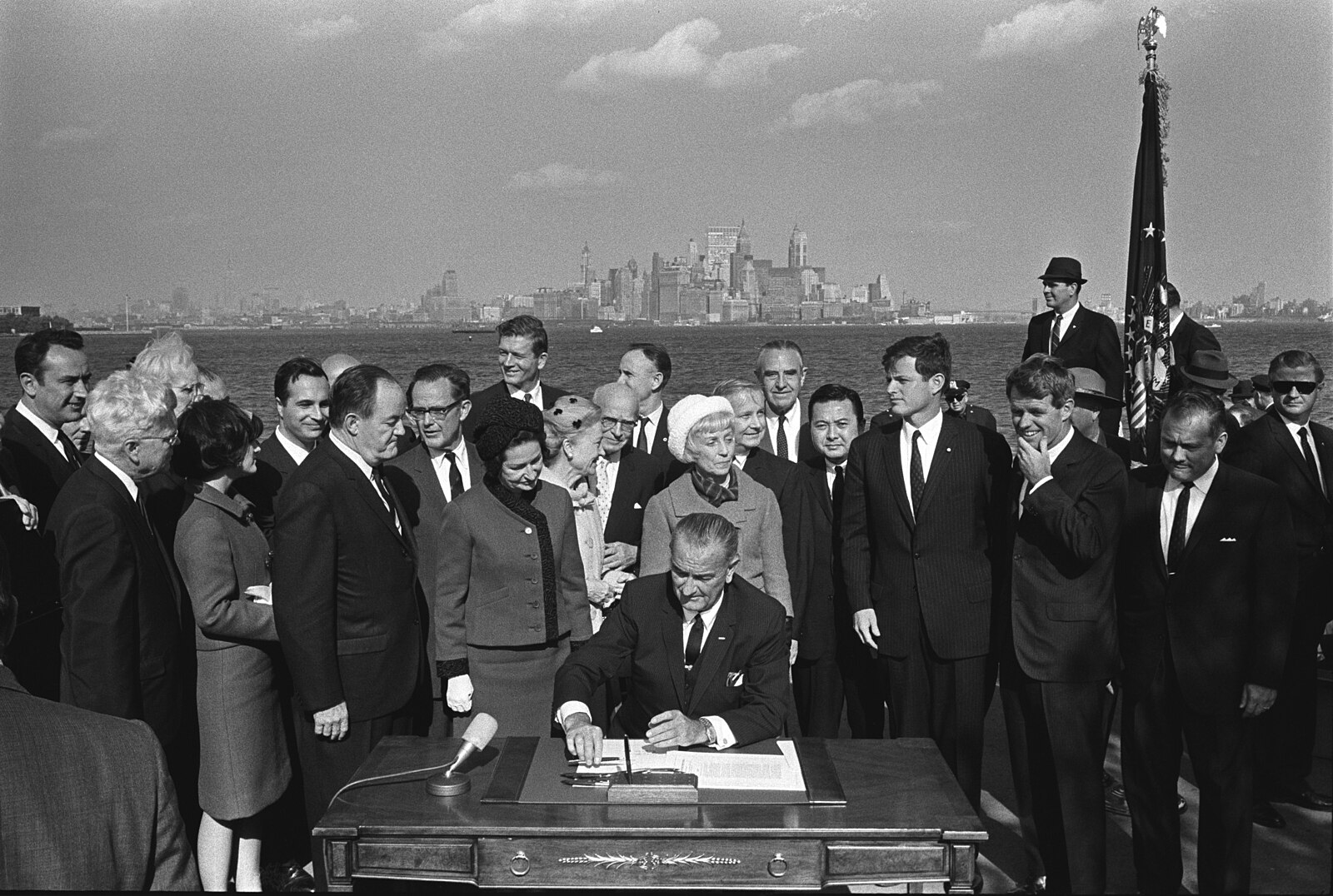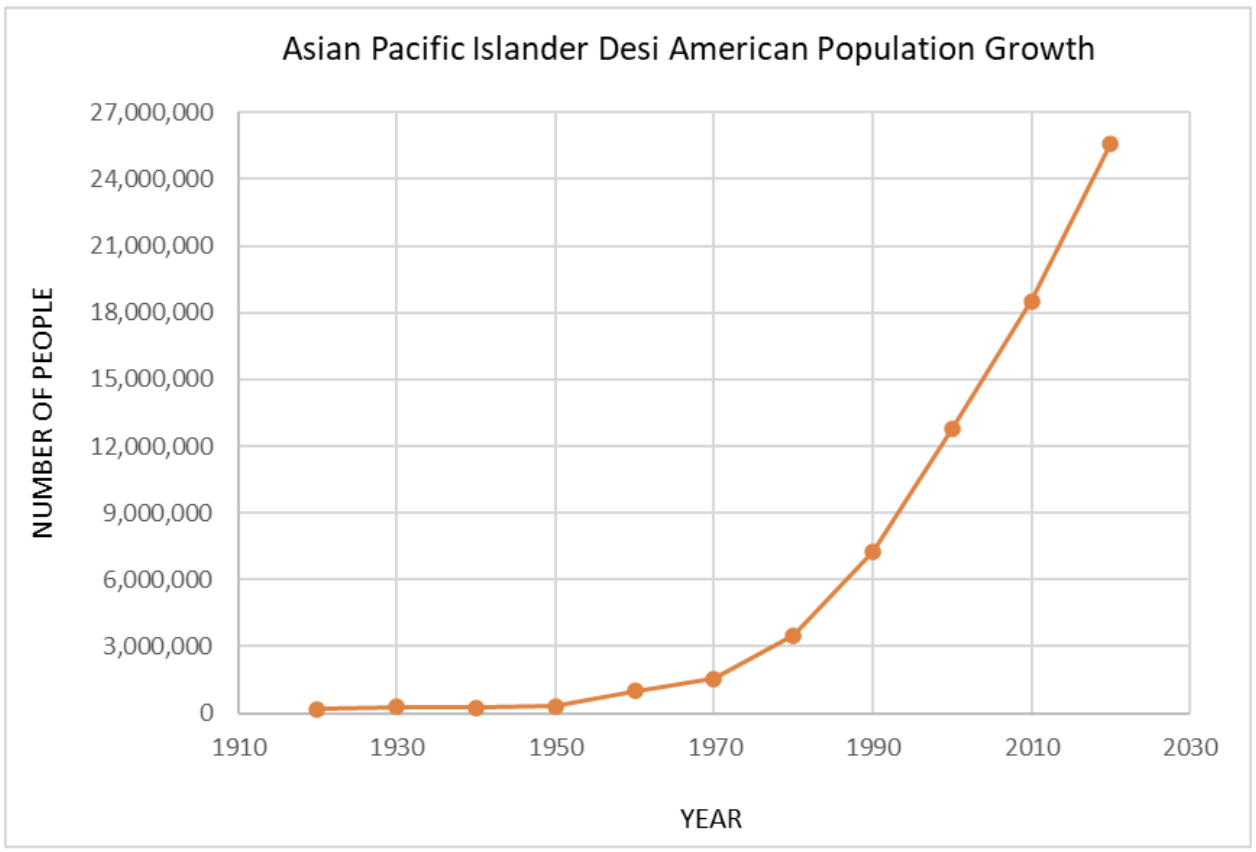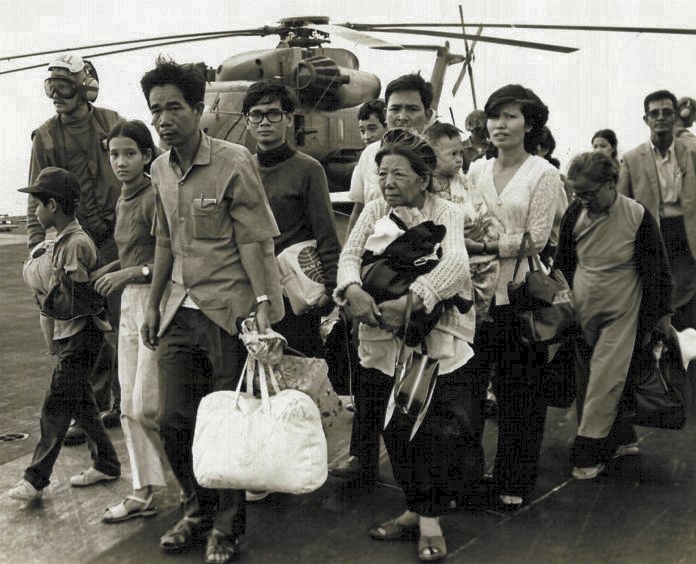3.5.0 - Citizenship and Immigration during the Civil Rights Movement Era
The Asian American Education Project
Grade: 7-10Subject:
U.S. History, Social Studies
Number of Lessons/Activities: 4
From the early 1800s to 1965, Asian Americans’ rights to immigration and citizenship in the United States were severely limited by a series of discriminatory immigration laws. In the wake of the Civil Rights Movement, Congress passed the Immigration and Nationality Act of 1965, which opened the doors to many Asian, African, and Latin American immigrants. In this lesson, students examine data on the demographics of the U.S. pre- and post-1965 to draw conclusions about the impact of the Immigration and Nationality Act of 1965.
In what ways did the Immigration and Nationality Act of 1965, in conjunction with other immigration reforms, impact the Asian Pacific Islander Desi American (APIDA) population and communities?
Students will:
- Examine and employ graph or visual data to compare the demographics of the U.S. pre- and post-1965 in order to measure the long-term and present-day impacts of the Immigration and Nationality Act of 1965.
Citizenship and Immigration during the Civil Rights Movement Era Essay:
Background:
Historically, the United States has used immigration policies to preserve and maintain a white-majority population and society. As economic conditions, racial concerns, or international relations shifted, the United States has opened or closed its borders to non-white populations. For example, when Chinese labor was pivotal to U.S. expansion, they were welcomed. But when those workers chose to settle instead of returning to China, they were viewed as a threat by white people. The Chinese were excluded from immigration until the United States was compelled to promote more friendly relations with China during World War II when it was at war with Japan. These racial, political, and international factors continue to affect immigration policies today.
Essay:
From the early 1800s to 1965, Asian Americans’ rights to immigration and citizenship in the United States were severely limited by a series of discriminatory immigration laws. Fears about the influx of Chinese labor taking away jobs from white workers led to the 1882 Chinese Exclusion Act, which explicitly banned Chinese immigrants from entering the country and prevented existing Chinese residents from becoming citizens. It was the first law in the United States to limit immigration based explicitly on ethnicity, and later expanded to exclude all Asians.
The Emergency
Quota Act (Emergency Immigration Act of 1921) implemented a quota system based on
nationality that overwhelmingly favored immigrants from Western Europe and barred immigrants from the vast majority of Asia and Africa. The Quota Act limited the annual number of immigrants admitted from any country to 3% of the total number of U.S. residents from that country based on the 1910
Census. Accordingly, the annual quota from Europe was 356,081, compared to 1,261 from Asia, and 122 from Africa.
When China became a key ally of the United States against Japan during World War II, Japan used the Chinese Exclusion Act as
propaganda for China to break their alliance with the U.S. No longer able to justify the exclusion, the United States repealed the Chinese Exclusion Act in 1943.
In 1952, the McCarran-Walter Act (Immigration and Nationality Act) attempted to reform immigration laws as critics believed they crippled U.S. international relations. While the Act removed past racial restrictions on citizenship by permitting naturalization, it retained discriminatory quotas that continued to favor western and northern European nations, which received 85% of the total spots. The stringent quota system and anti-immigration sentiment remained firmly unchanged for the next decade.
The Civil Rights
Movement of the 1950s and 1960s, spearheaded by the African American community and leaders like Dr. Martin Luther King, Jr., led to the passage of the Civil Rights Act of 1964, outlawing discrimination on the basis of race, color, religion, sex, or national origin. Subsequently, immigration laws based on national origin, such as the quota system that regarded immigrants from certain nations to be less desirable, came under serious review.
The passage of the Immigration and Nationality Act of 1965 (Hart-Celler Act) created a system that relied on “preferences” for immigrants who were highly skilled in fields that the Department of Labor deemed understaffed, or who had existing family relationships within the United States. Completely eliminating the use of quotas, this opened the doors to many Asian, African, and Latin American immigrants after decades of discriminatory and exclusionary immigration policies. The 1965 Immigration Act created a system of preferences that placed family
reunification at the top (75%), followed by skilled employment (20%), and refugees (5%).
Legislators at the time believed that the Immigration and Nationality Act of 1965 was symbolic rather than consequential. Upon signing it, President Lyndon B. Johnson remarked, “This bill that we will sign today is not a revolutionary bill. It does not affect the lives of millions. It will not reshape the structure of our daily lives, or really add importantly to either our wealth or power.” Though the bill was signed under the guise of progressivism, many legislators, including Senator Hiram Fong of Hawaiʻi, still had to placate xenophobic anxieties about Asian immigration and that those arriving would still remain majority European.
As immigration opened for family reunification and skilled workers, the Asian Pacific Islander Desi American (APIDA) population grew from 1.5 million in 1970 to 3.5 million in 1980, and doubled again to over 7 million by 1990. Part of the increase in the APIDA population can also be attributed to refugee resettlement: a series of wars were fought in Southeast Asia from 1946 to 1991, significantly impacting Vietnam, Laos, and Cambodia. By 1975, roughly 130,000 refugees fled Vietnam, Laos and Cambodia and resettled in the U.S., with about 1.2 million Southeast Asians fleeing to the United States by 2010. By the 21st century, 80 percent of immigrants to the United States were coming from Asia or Latin America, effectively transforming the demographics of American society.
While there are no longer racially exclusionary laws impacting an immigrant’s ability to immigrate or ability to naturalize, gaining citizenship is still difficult due to the length, cost, and stipulations of the process. Additionally, just as there were political motives behind past exclusionary immigration laws, the idea of opening up or easing pathways to citizenship is also a political issue. Some want to keep these barriers up to prevent, for example, undocumented immigrants, from obtaining citizenship. Just as immigration was controlled to exclude largely people of color from entering the U.S., barriers to citizenship for immigrants are tied to the motivation of keeping and maintaining the power of whiteness in the United States.
Bibiliography:
- Census: an official, government-conducted count or survey of a population, typically recording various details of individuals such as age, race, gender/sex, and more
- Movement: a gradual development or change of an attitude, opinion, or policy; often a result of collective organizing
- Nationality: the status of belonging to a particular nation or country
- Propaganda: information, especially of a biased or misleading nature, used to promote or publicize a particular political cause or point of view
- Quota: a fixed number of people allowed to do or get something
- Reunification: to bring (people or things) together after a period of separation; in this context, family reunification refers to allowing people who are already in the U.S. to help their immediate family immigrate to the U.S. and join them here
- When the Emergency Quota Act (1921) was enacted, what was immigration to the United States based on? Was this fair? Why or why not?
- How did the Immigration and Nationality Act of 1965 change the ethnic composition of the United States?
- How did U.S. immigration policies prior to 1965 affect APIDA communities? How did the Immigration and Nationality Act of 1965 affect APIDA communities?
- How are immigration and citizenship connected?
South Vietnamese refugees walk across a U.S. Navy vessel as part of Operation Frequent Wind, the final operation to evacuate people from Saigon from April 29-30, 1975. In the 1970s, many Southeast Asians fled from their homelands and resettled in the United States, facing many hardships and obstacles.
Credit: U.S. Marines in Japan Homepage, Public domain, via Wikimedia Commons
Activity 1: Understanding Immigration
- Pose this scenario to the class: “Imagine you live in a neighborhood made up of people who have lived in the United States for a long time and now several new immigrant families moved into the neighborhood. How might your neighborhood change as a result? What are the benefits and challenges of supporting new immigrants?” Allow students to share their responses.
- NOTE TO TEACHER: This conversation may get political. Remind students of the importance of humanizing immigrants and to challenge ideas and not people.
- Explain that a refugee is a person who has been forced to leave their country in order to escape war, persecution, or natural disaster. Explain that in the 1970s, many Southeast Asians fled from their homelands and resettled in the United States, facing many hardships and obstacles.
- Show students this video which is an oral history video (primary source) by Lar Soe (Soe is a Karen refugee born in a refugee camp in Thailand in 2000. She came to the United States in 2011.): https://umedia.lib.umn.edu/item/p16022coll554:10
- Give students an opportunity to respond to Lar Soe’s experiences.
- NOTE TO TEACHERS: As an extension, implement this lesson plan from The Asian American Education Project to learn more about the Southeast Asian refugees: https://asianamericanedu.org/southeast-asian-refugees.html. In this lesson, students will learn about the migration of Southeast Asian refugees who immigrated into the United States after the Vietnam War. Students will examine dominant narratives and counter-narratives about the Vietnam War. Students will also learn about U.S. refugee laws and programs and examine present-day world refugees. Ask these discussion questions after implementing the lesson: How are Southeast Asian refugees different from other U.S. immigrants? What is the role and responsibility of the United States in regard to the Southeast Asian refugees? To what extent did the United States fulfill its responsibility? What more can the United States do?
- Ask students to imagine how a new immigrant might feel. Have them consider what support and resources they might need, what fears and anxieties they may have, etc.
- Inform students that over the course of U.S. history, immigration has been based on various policies, U.S. international relations, ideologies, etc.

In 1965, President Lyndon B. Johnson signed the Immigration and Nationality Act, which led to a more inclusive era of immigration policies and a significant increase in the APIDA population.
Activity 2: Immigration Legislation and Demographic Changes
- Have students read the essay about the Immigration and Nationality Act of 1965 (see worksheet entitled, “Essay: Citizenship and Immigration during the Civil Rights Movement Era”).
- NOTE TO TEACHER: If you have limited classroom time, have students complete the reading as a homework assignment the night before you implement this lesson.
- Facilitate a discussion about the essay using the Discussion Questions.
- NOTE TO TEACHER: If time permits and if students need more support, watch the video in and/or implement The Asian American Education Project’s lesson entitled, “Immigration and Nationality Act of 1965 – Civil Rights Movement Era”: https://asianamericanedu.org/immigration.html
- Distribute the worksheet entitled “Racial and Ethnic Demographics of U.S. Population Pre- and Post-1965.” Have students work in pairs to complete the worksheet and then discuss the responses as a class:
- Explain that graphs are text features that convey information; they show the connections and interrelations between two or more things.
- Model how to closely read and review graphical data on the worksheet.
- NOTE TO TEACHER: If needed, explain the parts of a graph: axis lines, units, intervals, data, title, etc. Also, explain that there are different types of graphs: line, bar, circle, etc. The type of graph depends on the data.
- NOTE TO TEACHER: See Answer Key.

Students will interpret this graph to draw conclusions about the impacts of the Immigration and Nationality Act of 1965.
Activity 3: Interpreting Data on Population Growth
- Distribute the worksheet entitled, “APIDA Population Growth” and have students study the graph before answering the questions:
- Ask students to identify the graph name and axis titles.
- Ask students to identify the source. Discuss why the source is important and how it could impact the data.
- Have students work independently or in pairs to complete the worksheet.
- Discuss answers as a group.
- NOTE TO TEACHER: See Answer Key.
- Have students complete the worksheet questions independently or in small groups before reviewing responses as a class. Facilitate a discussion about the worksheet given the following prompts:
- What is the graph showing and how does it fit into what you know about U.S. history of immigration?
- Where does the Immigration and Nationality Act of 1965 fit into the graph?
- What did you learn from the graph data?
- What is the graph not telling you?
- Who or what is left out of the data? Who or what is hidden? What questions are not answered by the data? (Frame the discussion by having students think about Southeast Asians, Native Hawaiians, and Pacific Islanders.)
- What other observations or questions do you have?
- NOTE TO TEACHERS: The APIDA community stresses the importance of disaggregating data to focus on specific ethnic groups. For example, students may have questions about which ethnic groups are included in the graph. The data does not show the population growth for specific ethnicities, rather it lumps all APIDA groups together. This is because the data set includes anyone who had marked "Asian" alone or in combination with another race (identifying as multiracial) on the U.S. Census or who had marked "Pacific Islander or Native Hawaiian" alone or in combination with another race (identifying as multiracial). Pacific Islanders and Native Hawaiians did not get their own category until 2000 and that was also the first year people could mark themselves as multi-racial.
- NOTE TO TEACHERS: As an extension activity, have students work in small groups and conduct their own research to address a topic or issue not addressed in the “APIDA Population Growth” graph but that shows the impact of the Immigration and Nationality Act of 1965:
- Have student groups choose a topic to study.
- Have student groups find some data points about the topic. (Make sure students have access to the Internet.)
- Have student groups create a graph of the data.
- Have student groups present the graph to classmates via short presentations or a gallery walk.
- Students can study specific ethnic groups, for example how the 1965 Act impacted Hmong refugees. Students can study future projections of specific APIDA communities. Students can study naturalized versus American-born citizens post-1965. Students can study registered voters pre- and post-1965.
- Assign students the following task for homework as an assessment: “In one page, describe how the Immigration and Nationality Act of 1965 impacted the APIDA population and communities.”

The Civil Rights Movement, spearheaded by the Black American community, led to the passage of the Civil Rights Act of 1964, outlawing discrimination on the basis of race, color, religion, sex, or national origin. Subsequently, immigration laws came under serious review.
Credit: “Civil Rights March on Washington, D.C.” by Rowland Scherman, Public domain, via
Wikimedia Commons Source: U.S. National Archives and Records Administration
Activity 4: Reflecting on U.S. Immigration Policies
- Ask students to summarize the differences between early immigration policies faced by the Chinese in the 1800s and post-1965 immigration policies.
- Ask students to discuss how much immigration policies have improved and how much still needs to be done.
- NOTE TO TEACHERS: Note that immigration is the first step toward citizenship but obtaining citizenship is still a complicated process. Have students interview someone who is seeking naturalization or has been naturalized.
- NOTE TO TEACHERS: Encourage students to study data from the Pew Research Center about Asian Americans. For example, in 2021, the Center created a report on “Key Facts about Asian Americans”: https://www.pewresearch.org/fact-tank/2021/04/29/key-facts-about-asian-americans/. Have students look for the most recent report.
- If you are teaching this lesson as part of the Citizenship unit: Inform students they will be learning about Islamophobia and how APIDA people continue to struggle to be seen as Americans and/or to obtain the benefits of American citizenship.



